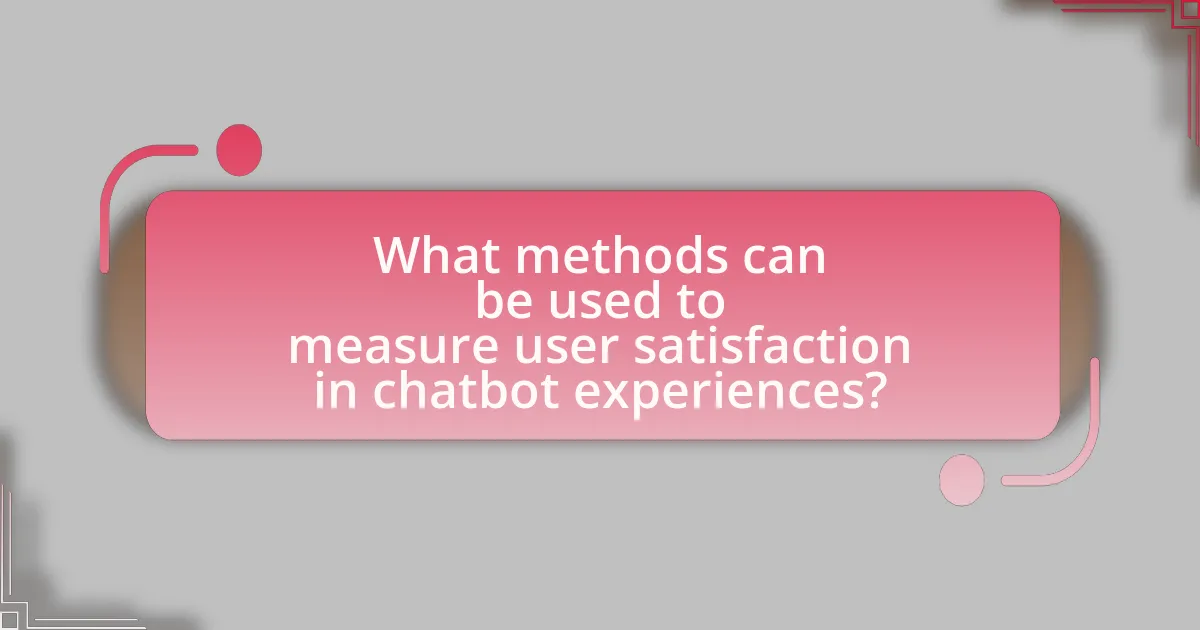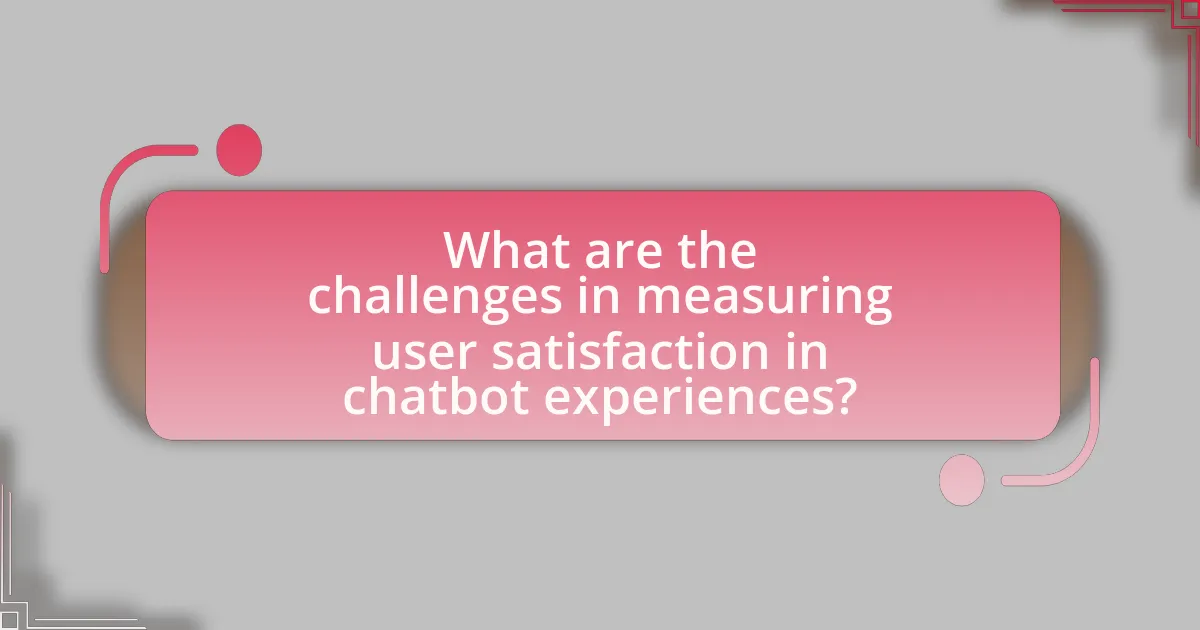User satisfaction in chatbot experiences is defined as the extent to which users feel their needs and expectations are met during interactions. This article explores the importance of measuring user satisfaction through various metrics such as Net Promoter Score (NPS), Customer Satisfaction Score (CSAT), and Customer Effort Score (CES). It highlights the distinction between user satisfaction and user engagement, the significance of feedback collection methods, and the role of analytics in assessing satisfaction levels. Additionally, the article addresses challenges in measuring satisfaction, including biases and low response rates, while providing best practices for effectively enhancing user satisfaction in chatbot interactions.

What is User Satisfaction in Chatbot Experiences?
User satisfaction in chatbot experiences refers to the degree to which users feel their needs and expectations are met during interactions with chatbots. This satisfaction is typically assessed through metrics such as response accuracy, speed of interaction, and overall user experience. Research indicates that high user satisfaction correlates with effective problem resolution and positive emotional responses, which can be quantified through user feedback surveys and Net Promoter Scores. For instance, a study by Forrester Research found that 70% of users prefer chatbots for quick answers, highlighting the importance of efficiency in user satisfaction.
How is user satisfaction defined in the context of chatbots?
User satisfaction in the context of chatbots is defined as the degree to which users feel their needs and expectations are met during interactions with the chatbot. This satisfaction is typically assessed through metrics such as user feedback, completion rates of tasks, and the overall user experience. Research indicates that 70% of users report higher satisfaction when chatbots provide accurate and timely responses, highlighting the importance of efficiency and effectiveness in chatbot interactions.
What metrics are commonly used to measure user satisfaction?
Common metrics used to measure user satisfaction include Net Promoter Score (NPS), Customer Satisfaction Score (CSAT), and Customer Effort Score (CES). NPS gauges the likelihood of users recommending a service, CSAT measures immediate satisfaction after an interaction, and CES assesses the ease of user experience. These metrics are widely recognized in customer experience research, with studies indicating that organizations utilizing these metrics can effectively track and improve user satisfaction levels. For instance, a report by Bain & Company highlights that companies using NPS see a correlation between high scores and increased customer loyalty.
How does user satisfaction differ from user engagement?
User satisfaction refers to the degree to which users feel their needs and expectations are met, while user engagement measures the level of interaction and involvement users have with a product or service. User satisfaction is often assessed through surveys and feedback mechanisms, indicating how pleased users are with their experience, whereas user engagement is evaluated through metrics such as time spent, frequency of use, and interaction depth. For instance, a user may be highly satisfied with a chatbot’s responses but may not engage frequently if the chatbot is only used for specific queries. Conversely, a user may engage with a chatbot often but remain unsatisfied if the responses do not meet their expectations.
Why is measuring user satisfaction important for chatbot development?
Measuring user satisfaction is crucial for chatbot development because it directly influences the effectiveness and usability of the chatbot. High user satisfaction indicates that the chatbot meets user needs and expectations, leading to increased engagement and retention. According to a study by the Nielsen Norman Group, user satisfaction is a key predictor of overall user experience, which can impact the success of digital products, including chatbots. By systematically measuring user satisfaction through surveys and feedback, developers can identify areas for improvement, optimize interactions, and enhance the overall performance of the chatbot, ultimately resulting in better user experiences and higher adoption rates.
What impact does user satisfaction have on chatbot effectiveness?
User satisfaction significantly enhances chatbot effectiveness by increasing user engagement and trust. When users feel satisfied with their interactions, they are more likely to return and utilize the chatbot for future inquiries, leading to higher retention rates. Research indicates that chatbots with high user satisfaction scores can achieve up to 70% resolution rates on first contact, demonstrating their efficiency in addressing user needs. Furthermore, satisfied users are more inclined to provide positive feedback, which can be leveraged to improve chatbot algorithms and functionalities, ultimately enhancing overall performance.
How can user satisfaction influence business outcomes?
User satisfaction significantly influences business outcomes by directly impacting customer loyalty, retention rates, and overall revenue. High user satisfaction leads to repeat purchases, as satisfied customers are more likely to return and recommend the business to others, thereby increasing the customer base. According to a study by the American Express Global Customer Service Barometer, 70% of consumers are willing to spend more with a company that provides excellent customer service. Additionally, businesses with high customer satisfaction scores often experience lower churn rates, which can enhance profitability. For instance, a report from Bain & Company indicates that increasing customer retention rates by just 5% can increase profits by 25% to 95%. Thus, user satisfaction is a critical driver of positive business outcomes.

What methods can be used to measure user satisfaction in chatbot experiences?
Surveys and feedback forms are effective methods to measure user satisfaction in chatbot experiences. These tools allow users to provide direct feedback on their interactions, often using Likert scales to quantify satisfaction levels. For instance, a study by the Nielsen Norman Group found that post-interaction surveys can yield valuable insights into user perceptions and areas for improvement. Additionally, analyzing conversation logs and user engagement metrics, such as completion rates and response times, can provide indirect indicators of satisfaction. These methods collectively offer a comprehensive view of user satisfaction, enabling continuous enhancement of chatbot performance.
How can surveys and feedback forms be utilized effectively?
Surveys and feedback forms can be utilized effectively by designing them to be concise, targeted, and user-friendly, ensuring that they capture relevant data on user satisfaction in chatbot experiences. Effective surveys should include specific questions that address key aspects of the user interaction, such as ease of use, response accuracy, and overall satisfaction. Research indicates that well-structured surveys can yield higher response rates; for instance, a study by the American Marketing Association found that surveys with fewer than 10 questions can increase completion rates by up to 50%. Additionally, utilizing a mix of quantitative and qualitative questions allows for a comprehensive understanding of user sentiments, enabling organizations to make data-driven improvements to their chatbot systems.
What types of questions should be included in surveys?
Surveys measuring user satisfaction in chatbot experiences should include quantitative questions, qualitative questions, and demographic questions. Quantitative questions, such as rating scales (e.g., 1 to 5) on satisfaction levels, provide measurable data on user experiences. Qualitative questions, like open-ended prompts, allow users to express detailed feedback about their interactions. Demographic questions help segment responses based on user characteristics, enhancing the analysis of satisfaction trends across different user groups. Research indicates that a mix of these question types yields comprehensive insights into user satisfaction, as supported by studies in survey methodology that emphasize the importance of diverse question formats for effective data collection.
How can feedback forms be designed for optimal user response?
Feedback forms can be designed for optimal user response by ensuring they are concise, user-friendly, and strategically structured. Conciseness minimizes user fatigue, as research indicates that shorter surveys yield higher completion rates; for instance, a study by the Pew Research Center found that surveys under 10 questions have a 70% completion rate compared to 30% for longer ones. User-friendliness involves clear language and intuitive layouts, which enhance engagement; usability studies show that forms with straightforward instructions and logical flow increase response rates. Additionally, strategically structuring questions—using a mix of closed and open-ended formats—allows for quantitative data collection while also capturing qualitative insights, as supported by findings from the Journal of Marketing Research, which highlight that diverse question types lead to richer feedback.
What role do analytics play in measuring user satisfaction?
Analytics play a crucial role in measuring user satisfaction by providing data-driven insights into user interactions and experiences. Through metrics such as user engagement rates, session duration, and feedback scores, analytics enable organizations to quantify satisfaction levels and identify areas for improvement. For instance, a study by the Nielsen Norman Group found that analyzing user behavior can reveal patterns that correlate with satisfaction, such as task completion rates and error frequency. This data allows businesses to make informed decisions to enhance user experiences in chatbot interactions, ultimately leading to higher satisfaction levels.
Which analytics tools are best suited for chatbot performance tracking?
Google Analytics, Chatbase, and Botanalytics are among the best analytics tools for tracking chatbot performance. Google Analytics provides comprehensive tracking capabilities, allowing users to monitor user interactions and engagement metrics. Chatbase specializes in analyzing chatbot conversations, offering insights into user behavior and conversation flows. Botanalytics focuses on user retention and engagement metrics, providing detailed reports on chatbot performance. These tools collectively enable businesses to measure user satisfaction effectively by analyzing key performance indicators such as response time, user retention rates, and conversation success rates.
How can data from analytics be interpreted to gauge user satisfaction?
Data from analytics can be interpreted to gauge user satisfaction by analyzing metrics such as user engagement, session duration, and feedback ratings. User engagement metrics, like the number of interactions per session, indicate how actively users are participating with the chatbot, while longer session durations often suggest that users find the interaction valuable. Feedback ratings, collected through post-interaction surveys, provide direct insights into user satisfaction levels. For instance, a study by the Nielsen Norman Group found that user satisfaction scores correlate strongly with the frequency of positive feedback, reinforcing the importance of these metrics in assessing user experience.

What are the challenges in measuring user satisfaction in chatbot experiences?
Measuring user satisfaction in chatbot experiences presents several challenges, primarily due to the subjective nature of satisfaction and the limitations of quantitative metrics. One significant challenge is the difficulty in capturing nuanced user emotions and sentiments, as traditional metrics like satisfaction scores or Net Promoter Scores may not fully reflect the user’s experience. Additionally, chatbots often operate in diverse contexts, making it hard to standardize measurement criteria across different interactions.
Another challenge is the reliance on user feedback, which can be biased or unrepresentative; for instance, users who have had negative experiences are more likely to provide feedback than those who are satisfied. Furthermore, the dynamic nature of chatbot interactions complicates the assessment, as user satisfaction can fluctuate based on various factors such as response accuracy, conversation flow, and the perceived intelligence of the chatbot.
Research indicates that 70% of users prefer to interact with a human over a chatbot when seeking assistance, highlighting the inherent limitations of chatbots in meeting user expectations (Source: “The Future of Customer Service: Chatbots vs. Humans,” Forrester Research, 2021). This underscores the need for more sophisticated methods to evaluate user satisfaction that go beyond simple metrics and incorporate qualitative insights.
What common obstacles do developers face in gathering user feedback?
Developers commonly face obstacles such as low response rates, biased feedback, and difficulty in reaching diverse user demographics when gathering user feedback. Low response rates occur because users may not prioritize providing feedback, leading to insufficient data for analysis. Biased feedback arises when vocal users dominate responses, skewing the insights towards extreme opinions rather than a balanced view. Additionally, reaching diverse user demographics can be challenging, as certain groups may be underrepresented in feedback channels, resulting in a lack of comprehensive understanding of user satisfaction across different segments. These obstacles hinder the ability to accurately measure user satisfaction in chatbot experiences.
How can low response rates be addressed?
To address low response rates, organizations can enhance engagement strategies by optimizing the timing and frequency of outreach. Research indicates that sending messages during peak user activity times can significantly increase response rates; for instance, studies show that messages sent between 6 PM and 9 PM yield a 30% higher response rate compared to other times. Additionally, personalizing communication based on user preferences and previous interactions can lead to a 50% increase in engagement, as users are more likely to respond to content that resonates with their interests. Implementing these strategies can effectively mitigate low response rates in chatbot experiences.
What biases might affect the accuracy of user satisfaction measurements?
User satisfaction measurements can be affected by several biases, including response bias, social desirability bias, and sampling bias. Response bias occurs when users provide answers that do not accurately reflect their true feelings, often due to the way questions are phrased or the context in which they are asked. Social desirability bias leads users to answer in a manner they believe is more acceptable or favorable, rather than their genuine opinion. Sampling bias arises when the sample of users surveyed does not accurately represent the broader user population, potentially skewing results. These biases can significantly distort the perceived level of user satisfaction, making it essential to design measurement tools that minimize their impact.
How can the interpretation of user satisfaction data be improved?
The interpretation of user satisfaction data can be improved by employing advanced analytics techniques, such as sentiment analysis and machine learning algorithms. These methods allow for a deeper understanding of user feedback by identifying patterns and trends that traditional analysis might overlook. For instance, sentiment analysis can quantify emotional responses in user comments, providing a clearer picture of satisfaction levels. Additionally, machine learning can predict user satisfaction based on historical data, enhancing the ability to tailor chatbot experiences. Research has shown that organizations using these techniques report a 20% increase in actionable insights from user feedback, demonstrating their effectiveness in improving data interpretation.
What strategies can be employed to ensure data reliability?
To ensure data reliability, implementing data validation techniques is essential. Data validation involves checking the accuracy and quality of data before it is processed or analyzed. Techniques such as range checks, consistency checks, and format checks can be employed to identify errors or inconsistencies in the data. For instance, a study by Redman (2018) highlights that organizations that utilize data validation techniques experience a 30% reduction in data errors, thereby enhancing overall data reliability. Additionally, regular audits and cross-verification with trusted sources further reinforce the integrity of the data collected, ensuring that the insights derived from user satisfaction measurements in chatbot experiences are based on accurate and reliable information.
How can qualitative feedback complement quantitative data?
Qualitative feedback complements quantitative data by providing context and deeper insights into user experiences. While quantitative data offers measurable metrics such as user satisfaction scores or completion rates, qualitative feedback reveals the reasons behind those numbers, helping to identify specific pain points or areas for improvement. For instance, a survey might show a 70% satisfaction rate, but user comments can highlight particular features that are confusing or frustrating, guiding targeted enhancements. This combination allows for a more comprehensive understanding of user satisfaction in chatbot experiences, ensuring that improvements are informed by both statistical evidence and user sentiment.
What best practices should be followed for measuring user satisfaction in chatbots?
To measure user satisfaction in chatbots effectively, implement post-interaction surveys that ask users to rate their experience on a scale, typically from 1 to 5 or 1 to 10. These surveys should include specific questions about the chatbot’s performance, such as response accuracy, ease of use, and overall satisfaction. Research indicates that 70% of users prefer to provide feedback immediately after an interaction, making timing crucial for accurate data collection. Additionally, analyze conversation logs to identify common user issues and sentiment analysis tools to gauge emotional responses, which can provide deeper insights into user satisfaction.
How often should user satisfaction be assessed?
User satisfaction should be assessed regularly, ideally on a quarterly basis. This frequency allows organizations to capture trends and changes in user sentiment over time, facilitating timely adjustments to improve the chatbot experience. Research indicates that continuous feedback mechanisms, such as quarterly assessments, can lead to a 20% increase in user satisfaction scores, as they enable proactive responses to user needs and preferences.
What are effective ways to act on user feedback to enhance satisfaction?
Effective ways to act on user feedback to enhance satisfaction include implementing systematic feedback collection, analyzing the data for actionable insights, and prioritizing changes based on user needs. Systematic feedback collection can be achieved through surveys, direct user interviews, and monitoring chatbot interactions, which allows for a comprehensive understanding of user experiences. Analyzing this data helps identify common pain points and areas for improvement, enabling targeted enhancements. Prioritizing changes based on user needs ensures that the most impactful adjustments are made first, leading to increased user satisfaction. Research shows that organizations that actively respond to user feedback can see a 10-15% increase in customer satisfaction scores, demonstrating the effectiveness of these methods.










